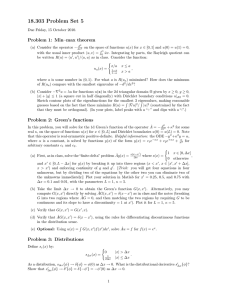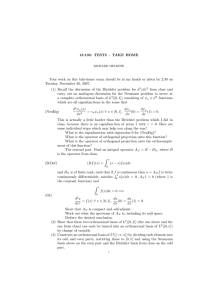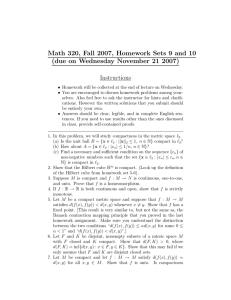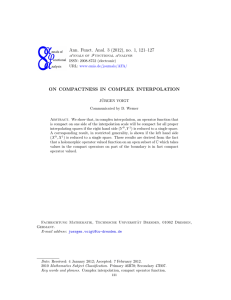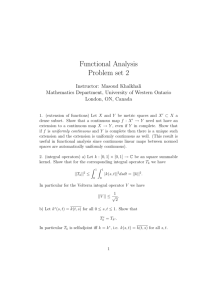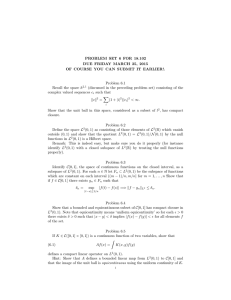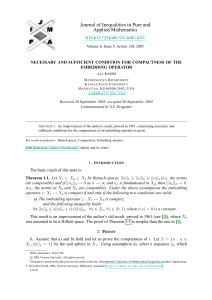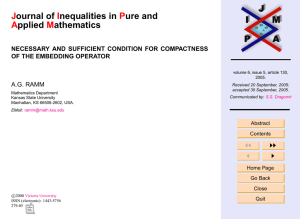18.102: NOTES ON DIRICHLET PROBLEM ON AN INTERVAL
advertisement
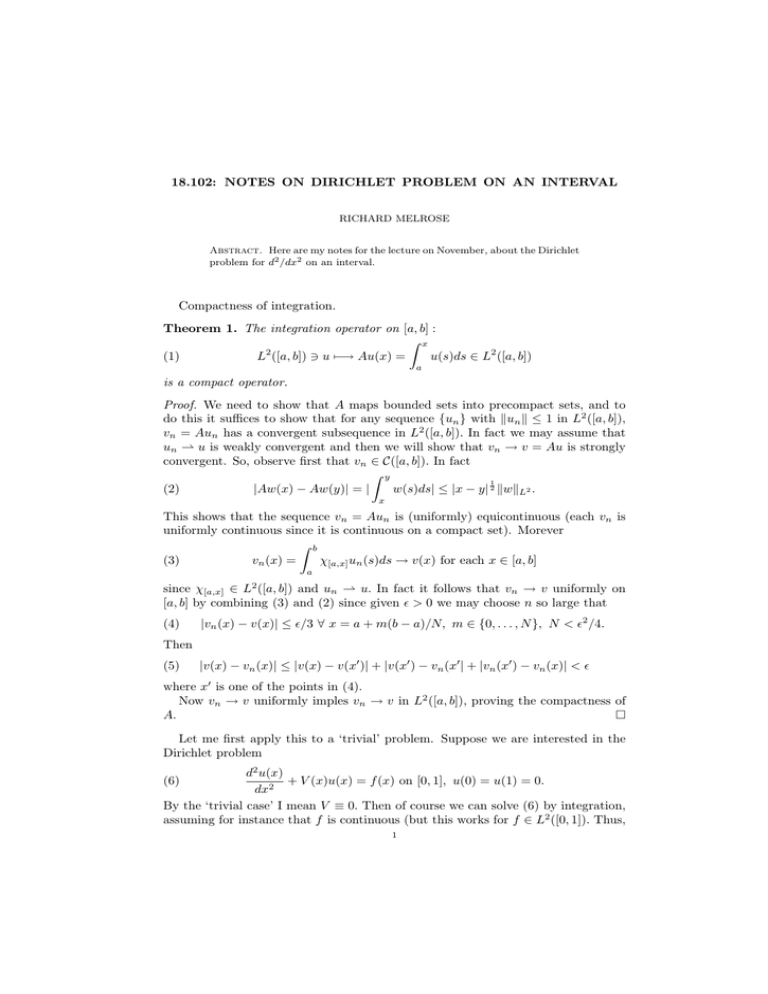
18.102: NOTES ON DIRICHLET PROBLEM ON AN INTERVAL
RICHARD MELROSE
Abstract. Here are my notes for the lecture on November, about the Dirichlet
problem for d2 /dx2 on an interval.
Compactness of integration.
Theorem 1. The integration operator on [a, b] :
Z x
2
(1)
L ([a, b]) 3 u 7−→ Au(x) =
u(s)ds ∈ L2 ([a, b])
a
is a compact operator.
Proof. We need to show that A maps bounded sets into precompact sets, and to
do this it suffices to show that for any sequence {un } with kun k ≤ 1 in L2 ([a, b]),
vn = Aun has a convergent subsequence in L2 ([a, b]). In fact we may assume that
un * u is weakly convergent and then we will show that vn → v = Au is strongly
convergent. So, observe first that vn ∈ C([a, b]). In fact
Z y
1
(2)
|Aw(x) − Aw(y)| = |
w(s)ds| ≤ |x − y| 2 kwkL2 .
x
This shows that the sequence vn = Aun is (uniformly) equicontinuous (each vn is
uniformly continuous since it is continuous on a compact set). Morever
Z b
(3)
vn (x) =
χ[a,x] un (s)ds → v(x) for each x ∈ [a, b]
a
2
since χ[a,x] ∈ L ([a, b]) and un * u. In fact it follows that vn → v uniformly on
[a, b] by combining (3) and (2) since given > 0 we may choose n so large that
(4)
|vn (x) − v(x)| ≤ /3 ∀ x = a + m(b − a)/N, m ∈ {0, . . . , N }, N < 2 /4.
Then
(5)
|v(x) − vn (x)| ≤ |v(x) − v(x0 )| + |v(x0 ) − vn (x0 | + |vn (x0 ) − vn (x)| < where x0 is one of the points in (4).
Now vn → v uniformly imples vn → v in L2 ([a, b]), proving the compactness of
A.
Let me first apply this to a ‘trivial’ problem. Suppose we are interested in the
Dirichlet problem
d2 u(x)
+ V (x)u(x) = f (x) on [0, 1], u(0) = u(1) = 0.
dx2
By the ‘trivial case’ I mean V ≡ 0. Then of course we can solve (6) by integration,
assuming for instance that f is continuous (but this works for f ∈ L2 ([0, 1]). Thus,
(6)
1
2
RICHARD MELROSE
integrating twice gives a solution of the differential equation
Z xZ t
f (s)dsdt.
(7)
Bf (x) =
0
0
From the discussion above we see immediately that B : L2 ([0, 1]) −→ L2 ([0, 1]) is
compact. Clearly Bf (0) = 0 but on the other hand
Z 1
Z 1Z t
f (s)dsdt =
(1 − s)f (s)ds = B1 f
(8)
Bf (1) =
0
0
0
need not vanish. However there are solutions to the homogeneous equation, (6)
with f ≡ 0, namely any linear function. Of course we don’t want to mess up the
fact that Bf (0) = 0 so we should only add cx to this. Choosing c correctly, namely
Af (x) = Bf (x) − (B1 f )x
(9)
ensures that u(x) = Af (x) satisfies (6) (at least if f is continuous) including the
boundary conditions.
Proposition 1. The operator A in (9) is a compact and self-adjoint as an operator
on L2 ([0, 1]).
Proof. Since x is a fixed function and B1 f is a constant, the extra term in (9) is
finite rank. Thus the compactness of A follows from that of B – in fact B is the
composite of two compact operators.
To see the self-adjointness of A we just need to compute its adjoint! First we
can change the order of integration to write
Z x
(10)
Bf (x) =
(x − s)f (s)ds.
0
Then, computing the adjoint of B, by again changing the order of integration,
Z 1Z x
Z 1Z 1
hBf, φi =
(x − s)f (s)dsφ(x)dx =
(x − s)f (s)φ(x)dxds
0
0
Z
(11)
=
0
s
1
f (s)(B ∗ φ)(s)dxds = hf, B ∗ φi, where
0
(B ∗ φ)(x) =
Z
1
Z
(s − x)φ(s)ds =
1
x
Z
(s − x)φ(s)ds +
x
(x − s)φ(s)ds.
0
0
Similarly,
(12)
Z
1
Z
h(B1 f )x, φi =
(1 − s)f (s)dsxφ(x)dx
0
Z
1
Z
f (x)(1 − x)
=
0
1
0
1
Z
1
sφ(s)dsdx = hf, (B1 φ)xi +
0
Z
0
1
(s − x)φ(s)dsdx.
f (x)
0
Thus
(13)
A∗ = (B − (B1 f )x)∗ = A.
Thus A is indeed a compact self-adjoint operator. Let’s compute its eigenvalues,
using the uniqueness of solutions to ODEs (should I prove this?)
DIRICHLET
3
First the non-zero eigenvalues. If Au = λu with λ 6= 0 then we can write
u = λ−1 Au. Since Au is C 1 and vanishes at x = 0 and x = 1, so is and does u.
Moverover if u is C 1 then Au is C 2 and hence so is u. In fact this argument shows
that u is C ∞ but we do not need to check that, since by differentiating we see that
d2 u
= λ−1 u, u(0) = u(1) = 0.
dx2
So, now we can use the uniqueness of solutions to this ODE. There is a unique
solution √
of the Cauchy problem, with u(0) = 0 and u0 (0) = 1. In fact this function
is sin(x/ −λ). So λ = −T 2 < 0 necessarily and then for sin(T ) = 0 we must have
T = πn, n ∈ N. Thus the general solution to Au − λu with λ 6= 0 is
−1
(15)
u(x) = A sin(πnx), λ = 2 2 , n ∈ N.
π n
Now, we have to think about the null space of A, Au = 0. Differentiation once
shows that
Z x
(16)
u(s)ds = 0 a.e.
(14)
0
We already know that this implies that u = 0 in L2 ([0, 1]). Thus the null space is
trivial.
Now, applying the spectral theorem, we conclude that
(17)
φn (x) = sin(πnx), n ∈ N is a complete orthonormal basis of L2 ([0, 1]).
Department of Mathematics, Massachusetts Institute of Technology
E-mail address: rbm@math.mit.edu
